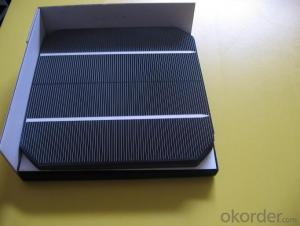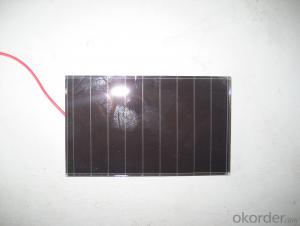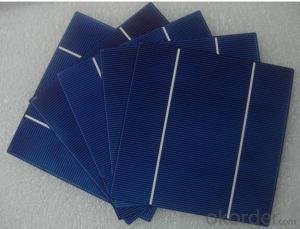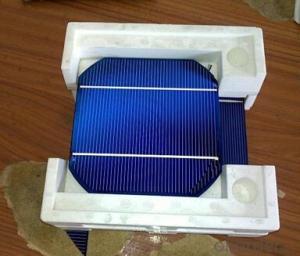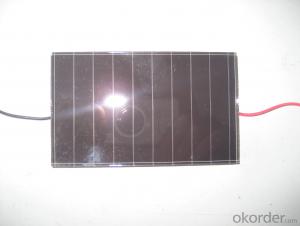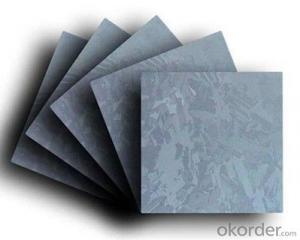Solar Cell High Quality A Grade Cell Polyrystalline 5v 16.2%
- Loading Port:
- Shanghai
- Payment Terms:
- TT OR LC
- Min Order Qty:
- 1000 pc
- Supply Capability:
- 100000 pc/month
OKorder Service Pledge
OKorder Financial Service
You Might Also Like
Specifications
hot sale solar cell
1.16.8%~18.25% high efficiency
2.100% checked quality
3.ISO9001/ISO14001/TUV/CE/UL
4.stable performance
We can offer you the best quality products and services, don't miss !
POLY6'(156*156)
Polycrystalline Silicon Solar cell
Physical Characteristics
Dimension: 156mm×156mm±0.5mm
Diagonal: 220mm±0.5mm
Thickness(Si): 200±20 μm
Front(-) Back(+)
Blue anti-reflecting coating (silicon nitride); Aluminum back surface field;
1.5mm wide bus bars; 2.0mm wide soldering pads;
Distance between bus bars: 51mm . Distance between bus bars :51mm .
Electrical Characteristics
Efficiency(%) | 18.00 | 17.80 | 17.60 | 17.40 | 17.20 | 16.80 | 16.60 | 16.40 | 16.20 | 16.00 | 15.80 | 15.60 |
Pmpp(W) | 4.33 | 4.29 | 4.24 | 4.19 | 4.14 | 4.09 | 4.04 | 3.99 | 3.94 | 3.90 | 3.86 | 3.82 |
Umpp(V) | 0.530 | 0.527 | 0.524 | 0.521 | 0.518 | 0.516 | 0.514 | 0.511 | 0.509 | 0.506 | 0.503 | 0.501 |
Impp(A) | 8.159 | 8.126 | 8.081 | 8.035 | 7.990 | 7.938 | 7.876 | 7.813 | 7.754 | 7.698 | 7.642 | 7.586 |
Uoc(V) | 0.633 | 0.631 | 0.628 | 0.625 | 0.623 | 0.620 | 0.618 | 0.617 | 0.615 | 0.613 | 0.611 | 0.609 |
Isc(A) | 8.709 | 8.677 | 8.629 | 8.578 | 8.531 | 8.478 | 8.419 | 8.356 | 8.289 | 8.220 | 8.151 | 8.083 |
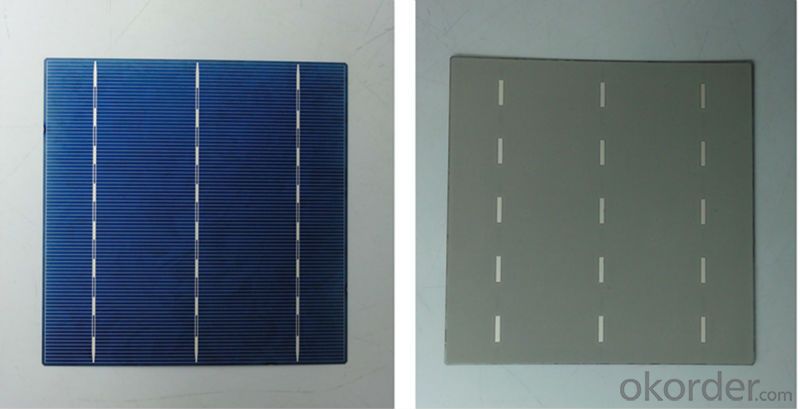
MONO5'(125*125mm)165
Monocrystalline silicon solar cell
Physical Characteristics
Dimension: 125mm×125mm±0.5mm
Diagonal: 165mm±0.5mm
Thickness(Si): 200±20 μm
Front(-) Back(+)
Blue anti-reflecting coating(silicon nitride); Aluminum back surface field;
1.6mmwide bus bars; 2.5mm wide soldering pads;
Distance between bus bars: 61mm . Distance between bus bars :61mm .
Electrical Characteristics
Efficiency(%) | 19.40 | 19.20 | 19.00 | 18.80 | 18.60 | 18.40 | 18.20 | 18.00 | 17.80 | 17.60 | 17.40 | 17.20 |
Pmpp(W) | 2.97 | 2.94 | 2.91 | 2.88 | 2.85 | 2.82 | 2.79 | 2.76 | 2.73 | 2.70 | 2.67 | 2.62 |
Umpp(V) | 0.537 | 0.535 | 0.533 | 0.531 | 0.527 | 0.524 | 0.521 | 0.518 | 0.516 | 0.515 | 0.513 | 0.509 |
Impp(A) | 5.531 | 5.495 | 5.460 | 5.424 | 5.408 | 5.382 | 5.355 | 5.328 | 5.291 | 5.243 | 5.195 | 4.147 |
Uoc(V) | 0.637 | 0.637 | 0.636 | 0.635 | 0.633 | 0.630 | 0.629 | 0.629 | 0.628 | 0.626 | 0.626 | 0.625 |
Isc(A) | 5.888 | 5.876 | 5.862 | 5.848 | 5.839 | 5.826 | 5.809 | 5.791 | 5.779 | 5.756 | 5.293 | 5.144 |

FAQ:
Q:How can i get some sample?
A:Yes , if you want order ,sample is not a problem.
Q:How about your solar panel efficency?
A: Our product efficency around 17.25%~18.25%.
Q:What’s the certificate you have got?
A: we have overall product certificate of ISO9001/ISO14001/CE/TUV/UL
- Q:What is the role of junction boxes on solar silicon wafers?
- Junction boxes on solar silicon wafers serve as a crucial component for connecting the electrical circuit of the solar panel. These boxes house the electrical connections, such as diodes and bypass diodes, which help regulate the flow of electricity and protect the solar cells from potential damage caused by factors like shading or overheating. Additionally, junction boxes also provide a secure enclosure for the wiring, ensuring safety and reliability of the solar panel system.
- Q:I would like to ask what the purpose of the use of semiconductor silicon wafers, doped with boron ah?
- High purity silicon wafers for use in electronics and solar energy are required to be doped with boron to manufacture the P end of the P - N junction, in which P (P) - N (As) -, Ga (B) - gallium (III) indium (III) - silicon.
- Q:Can solar silicon wafers be used in wearable fashion accessories?
- Yes, solar silicon wafers can be used in wearable fashion accessories. They can be integrated into various accessories like jewelry, clothing, or accessories such as bags and hats to harness solar energy for charging devices or powering other functionalities.
- Q:How do solar silicon wafers affect the aesthetics of buildings?
- Solar silicon wafers have a minimal impact on the aesthetics of buildings. While they are typically dark in color, their installation on rooftops or as building-integrated photovoltaic systems can blend seamlessly with the overall design. Additionally, advancements in solar technology have led to the development of solar panels that can mimic the appearance of traditional roofing materials, further reducing any visual impact on the building's aesthetics.
- Q:How are solar silicon wafers tested for quality control?
- Solar silicon wafers are tested for quality control through various methods, including visual inspection, electrical testing, and performance evaluation. Visual inspection involves examining the wafers for any physical defects or imperfections such as cracks, scratches, or impurities. Electrical testing measures the electrical properties of the wafers, such as resistivity and carrier concentration, to ensure they meet the required standards. Performance evaluation involves subjecting the wafers to simulated operating conditions, such as exposure to light and heat, to assess their efficiency and durability. These comprehensive testing procedures help ensure that only high-quality solar silicon wafers are used in the production of solar cells and panels.
- Q:How is the bandgap of a solar silicon wafer determined?
- The bandgap of a solar silicon wafer is determined by measuring the energy difference between the valence band and the conduction band of the material. This can be done through various techniques, such as optical absorption spectroscopy or photoluminescence measurements. By analyzing the absorption or emission of light at different wavelengths, the bandgap energy can be accurately determined, providing crucial information for optimizing solar cell performance.
- Q:What is the size of a typical solar silicon wafer?
- A typical solar silicon wafer has a size of around 156mm by 156mm, or 6 inches by 6 inches.
- Q:What is the role of metal contacts on solar silicon wafers?
- The role of metal contacts on solar silicon wafers is to provide electrical connections between the solar cells and external devices, such as wires or other components in the solar panel system. These contacts help to efficiently extract the generated electricity from the solar cells and transfer it to the desired output.
- Q:What is the role of front contacts on solar silicon wafers?
- The role of front contacts on solar silicon wafers is to facilitate the flow of current generated by the sunlight-absorbing material within the wafer. These contacts, typically made of metal, are strategically placed on the front surface of the wafer to create a conductive path for the generated electricity to be collected and transferred to the external circuitry. They help maximize the efficiency of the solar cell by minimizing resistive losses and allowing the harvested energy to be utilized for various applications.
- Q:How is a solar silicon wafer connected to other components in a solar panel?
- A solar silicon wafer is typically connected to other components in a solar panel through a series of electrical connections. These connections are made using conductive materials, such as metal ribbons or wires, which are soldered to the front and back contacts of the wafer. The ribbons or wires are then connected to the junction box of the solar panel, allowing for the transfer of electrical current generated by the wafer to other components, such as the inverter or battery, for further use or storage.
1. Manufacturer Overview |
|
|---|---|
| Location | |
| Year Established | |
| Annual Output Value | |
| Main Markets | |
| Company Certifications | |
2. Manufacturer Certificates |
|
|---|---|
| a) Certification Name | |
| Range | |
| Reference | |
| Validity Period | |
3. Manufacturer Capability |
|
|---|---|
| a)Trade Capacity | |
| Nearest Port | |
| Export Percentage | |
| No.of Employees in Trade Department | |
| Language Spoken: | |
| b)Factory Information | |
| Factory Size: | |
| No. of Production Lines | |
| Contract Manufacturing | |
| Product Price Range | |
Send your message to us
Solar Cell High Quality A Grade Cell Polyrystalline 5v 16.2%
- Loading Port:
- Shanghai
- Payment Terms:
- TT OR LC
- Min Order Qty:
- 1000 pc
- Supply Capability:
- 100000 pc/month
OKorder Service Pledge
OKorder Financial Service
Similar products
New products
Hot products
Related keywords
